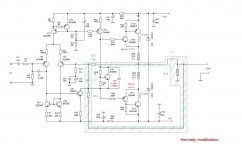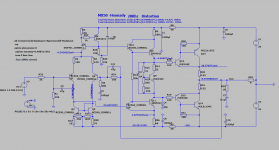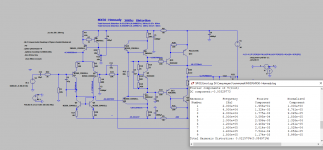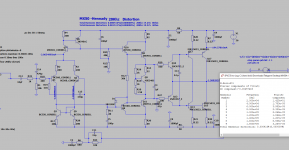it would be nice if in other editors to carry out simulation and compare.it remains to make wiring of board, make a gerber and go!)
right now I’m using a modified version of the frequency correction from the post for voice acting at home: https://www.diyaudio.com/community/threads/ljm-mx50-kit-amp.216609/post-7186490
thus, there are no problems with this modification of the frequency correction of the amplifier.
However, the question remained with the long tail of harmonics at high frequencies of the output assembly of Shiklai's power transistors. And there was even a question whether the selection of other transistors would affect the reduction in the level of harmonics at HF. The answer is that there is not much, because. the initial current for Shiklai at 185mA is not very large, but it turned out to be enough for a very high-quality audio sound.
Based on the work of Grem Schmidt, I tried to use his low-current bridge (bridge elements highlighted in green R15C7 and R16R18L1), for output power transistors in class B.
I had to sacrifice the depth of negative feedback, but distortion at an output power of 50 watts is no more than 0.008% (1kHz - 20kHz). At lower input voltages with an output power of up to 1 watt, distortion increases to 0.04% only at frequencies above 10 kHz.
With such a bridge, increasing the initial current above 17mA through the output stage transistors does not lead to a decrease in distortion.
I picked up the elements of the bridge, maybe I'll try to put it into practice in the model.
I had to sacrifice the depth of negative feedback, but distortion at an output power of 50 watts is no more than 0.008% (1kHz - 20kHz). At lower input voltages with an output power of up to 1 watt, distortion increases to 0.04% only at frequencies above 10 kHz.
With such a bridge, increasing the initial current above 17mA through the output stage transistors does not lead to a decrease in distortion.
I picked up the elements of the bridge, maybe I'll try to put it into practice in the model.
Attachments
In setting up a 3.0 surround (stereo) system I decided to build a couple of MX50 SE amps. for the fronts and dual mono center channel. The L-R fronts will be driven by a 100W/Ch. version and the dual center will be driven by a 55W/Ch. version. This is a great set-up for an apartment. I don’t like or need the extra wires for rear channels. Large and capable speakers (Bryston Mini-T) are used for the fronts and eliminate the need for a subwoofer. The Brystons go clean and deep into the mid 30’s.
The center channel is comprised of dual Jamo C-603’s. The control pre-amp is a Rotel RSP-1068 which I recently acquired but had to repair. The price was right and the repairs easier than I anticipated.
The front ch. Amp. uses parts from a used Sony integrated amp. The transformer, heatsinks, and 30A rectifier block. The end usable rail voltages are 42V +/-. Clipping is about 90+W/rms at 8 ohms.
The power supply rails are 20K mfd. per +/-. All rails are fused as well as the speakers.
The pcb. caps. have been bumped to 63V DC. The outputs have been changed to MJW3281 and MJW1302. I added 2K Bourns pots. to replace R19 for bias. The bias is set to 40ma across both output collector resistors. The heatsink is very robust and runs quite cool at higher levels. The DC balance was below 5mv for either channel as I matched the hfe for Q1 and Q2.
The center ch. Amp. Uses a 1980’s era Sansui transformer that puts out 27-0-27 AC. The rails end up at 38VDC. I did not change R19 as the bias measured about 30ma each channel. DC balance was measured below 10mv for either channel. The outputs are 2sc3856 and 2sa1492. All the rails are fused.
This amp. also runs quite cool. The power supply caps are about 14K mfd. per rail.
I did some preliminary testing with REW and the results were quite impressive. I will try to post later.
The center channel is comprised of dual Jamo C-603’s. The control pre-amp is a Rotel RSP-1068 which I recently acquired but had to repair. The price was right and the repairs easier than I anticipated.
The front ch. Amp. uses parts from a used Sony integrated amp. The transformer, heatsinks, and 30A rectifier block. The end usable rail voltages are 42V +/-. Clipping is about 90+W/rms at 8 ohms.
The power supply rails are 20K mfd. per +/-. All rails are fused as well as the speakers.
The pcb. caps. have been bumped to 63V DC. The outputs have been changed to MJW3281 and MJW1302. I added 2K Bourns pots. to replace R19 for bias. The bias is set to 40ma across both output collector resistors. The heatsink is very robust and runs quite cool at higher levels. The DC balance was below 5mv for either channel as I matched the hfe for Q1 and Q2.
The center ch. Amp. Uses a 1980’s era Sansui transformer that puts out 27-0-27 AC. The rails end up at 38VDC. I did not change R19 as the bias measured about 30ma each channel. DC balance was measured below 10mv for either channel. The outputs are 2sc3856 and 2sa1492. All the rails are fused.
This amp. also runs quite cool. The power supply caps are about 14K mfd. per rail.
I did some preliminary testing with REW and the results were quite impressive. I will try to post later.
Attachments
-
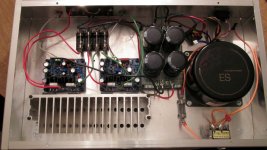 IMG_0339.JPG367.6 KB · Views: 219
IMG_0339.JPG367.6 KB · Views: 219 -
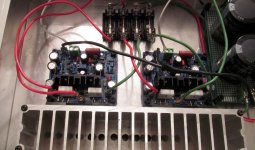 IMG_0340.JPG397.2 KB · Views: 224
IMG_0340.JPG397.2 KB · Views: 224 -
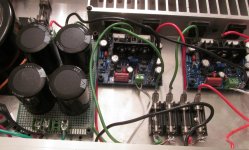 IMG_0341.JPG413.9 KB · Views: 229
IMG_0341.JPG413.9 KB · Views: 229 -
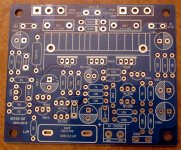 MX50se pcb 1 3-1-23.JPG739.6 KB · Views: 233
MX50se pcb 1 3-1-23.JPG739.6 KB · Views: 233 -
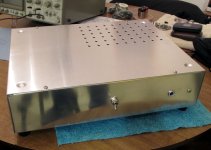 55W amp 1.JPG389.7 KB · Views: 229
55W amp 1.JPG389.7 KB · Views: 229 -
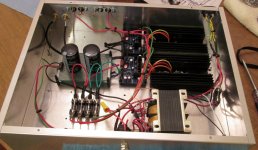 55W amp 2.JPG403.7 KB · Views: 190
55W amp 2.JPG403.7 KB · Views: 190 -
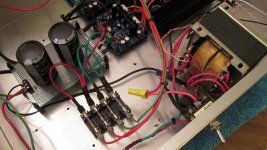 55W amp 3.JPG414.7 KB · Views: 188
55W amp 3.JPG414.7 KB · Views: 188 -
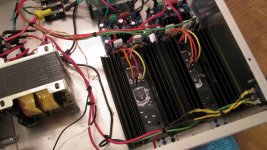 55W amp 4.JPG416.4 KB · Views: 205
55W amp 4.JPG416.4 KB · Views: 205 -
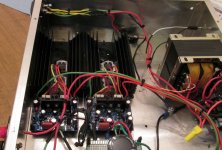 55W amp 5.JPG447.1 KB · Views: 197
55W amp 5.JPG447.1 KB · Views: 197 -
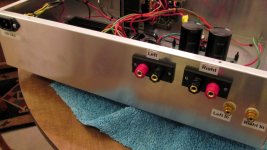 55W amp 6.JPG319.7 KB · Views: 232
55W amp 6.JPG319.7 KB · Views: 232
Perhaps it is worth showing this MX50 spectrum analyzer window snapshot. I've used linear averaging just to make my point clearer. The spectrum reveals why this amplifier board is widely recognized for likable sound.
Just observe distribution of its harmonics: even monotonically decreasing harmonics dominate whilst odd harmonics remain under -120dBV.

Just observe distribution of its harmonics: even monotonically decreasing harmonics dominate whilst odd harmonics remain under -120dBV.
So I've seen a few posts suggesting that the input cap C1 is not sufficient value for proper bass response. In running a freq. sweep below 200Hz with an 8 Ohm load, I'm not seeing the issue that some claim nor do I hear it! Is this a case of Golden ear audiophiles projecting their subjective science or have I missed the testing data! I compared this amp. with a Hafler DH-120 (subjectively) and I can't say one or the other has better bass response. My speakers are Bryston Mini-T's that dig pretty deep into the 30 Hz area. My C1 caps are the 3.3 uf.
This is a spectrum from the amp as-is without modifications?Perhaps it is worth showing this MX50 spectrum analyzer window snapshot. I've used linear averaging just to make my point clearer. The spectrum reveals why this amplifier board is widely recognized for likable sound.
Just observe distribution of its harmonics: even monotonically decreasing harmonics dominate whilst odd harmonics remain under -120dBV.
View attachment 1206567
The only, and the most important change, is that I have used original Toshiba output devices along with increased quiescent current. All small devices appear to be good.This is a spectrum from the amp as-is without modifications?
This midget implements Douglass Self's design and sounds great.
Good luck, ... but, for safety, buy original Toshibas to be sure you'll indeed have luck.
Last edited:
D
Deleted member 550749
Made this schematic, emitter resistor heating, parallel 0.47 = 0.235ohm resistor total capacity 4watt 🤔 and getting 0.400mv ac at the output what's wrong with this schematic, driver transistor used c4793/ 1837 UTC and output ttc 5200/1943New and best
I had two of these MX50 SE modules up on the shelf for a couple years never having tested them. At the time, I decided to buy assembled modules since the board and parts looked authentic. And the boards seemed well assembled. I also opted to get the ones using the SanKen output devices. So, I proceeded to test them and see how they performed. I used a +-36VDC SMPS supply, and slowly brought them up using the variac. To my surprise, no sparks or magic smoke! Just doing some casual listening on the bench these modules both operated flawlessly and sound very respectfully (with my smallish) test speakers.
They were clear, articulate, mids sounded well-balanced, and the bass punched with the authority for an ~80ish wpc amp. BTW, they are dead silent when the music paused with ear up to the speaker. For $14USD each, I'd say, you couldn't ask for much more. More serious listening is required before my final verdict, and after I finish up an enclosed amp. I let them play for about an hour each and the heatsink were barely warm to the touch.
Very much surprised by the sound of these amps. Over the years, I've used other models from LJM and always been satisfied by the sound.



They were clear, articulate, mids sounded well-balanced, and the bass punched with the authority for an ~80ish wpc amp. BTW, they are dead silent when the music paused with ear up to the speaker. For $14USD each, I'd say, you couldn't ask for much more. More serious listening is required before my final verdict, and after I finish up an enclosed amp. I let them play for about an hour each and the heatsink were barely warm to the touch.
Very much surprised by the sound of these amps. Over the years, I've used other models from LJM and always been satisfied by the sound.
- Home
- Amplifiers
- Solid State
- LJM MX50 kit amp
